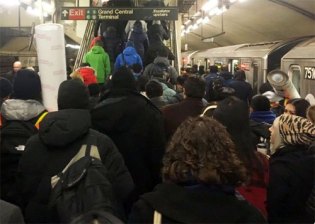The MTA Needs to Measure Service in a Way That People Understand

What if I told you that in the past year, the 4 train had a weekday “wait assessment” of 70 percent, down 1 percent from the previous year? Unless you’re a dyed in the wool transit geek, your eyes would probably glaze over.
But what if I told you that on average, 4 train riders lose three minutes to delays on the morning commute, and the delays are getting longer? That would probably stick with you.
The MTA only uses one of these metrics to communicate service reliability to the public, and it’s not the one that the public actually cares about.
In a post yesterday, TransitCenter made the case for the MTA to move beyond “wait assessment,” which measures the percentage of trains with significant delays, but doesn’t say much about the extent and impact of those delays. Instead, TransitCenter recommends tracking “excess journey time,” which they say is industry best practice because it’s both more precise and easier for transit riders to understand.
As TransitCenter’s Zak Accuardi wrote in May:
Wait assessment is indifferent to how late a train is or how many riders are affected by its lateness. On a line with service every four minutes, a gap of six minutes between trains in the Bronx at 6 A.M. is equally as ‘bad’ as a gap of 15 minutes between trains passing through Grand Central at rush hour.
In contrast, excess journey time (and its variant, “excess wait time”), paints a clearer picture of how much time the average rider loses to delays.
Compared to wait assessment, TransitCenter says, excess journey time is more legible to the public, because it is measured in minutes, not percentages, and more accurately reflects the fact that not all delays are created equal:
If excess journey time for the 6 Train is two minutes, then that means the average 6 Train rider loses two minutes of time on each ride due to delays. And a rush-hour melt-down affecting thousands would reflect more strongly than construction-related delay at 3 a.m.

But the MTA has defied advocates’ push for a more coherent metric. In July, agency spokesperson Kevin Ortiz defended wait assessment as the “primary indicator” of system performance. “Our service delivery focus is on evenness of service,” he told DNAinfo. “This is our focus because, generally speaking, our customers — relatively few of whom travel all the way to a terminal station — are more significantly affected by the time they wait for a train at a station along the route rather than the difference between the actual and scheduled arrival time at terminal stations.”
This excuse conveniently obscures the fact that “wait assessment” fails to communicate the time passengers “wait for a train at a station,” because it doesn’t communicate time at all. It also gives the misleading impression that “excess journey time” is only a reflection of delays for passengers traveling to the end of a line, when the metric can convey average delays for all passengers on a line.
Other transit agencies have adopted excess journey time, and developers in New York have figured out how to apply it to MTA bus routes using Bus Time data. When will the MTA catch up?


